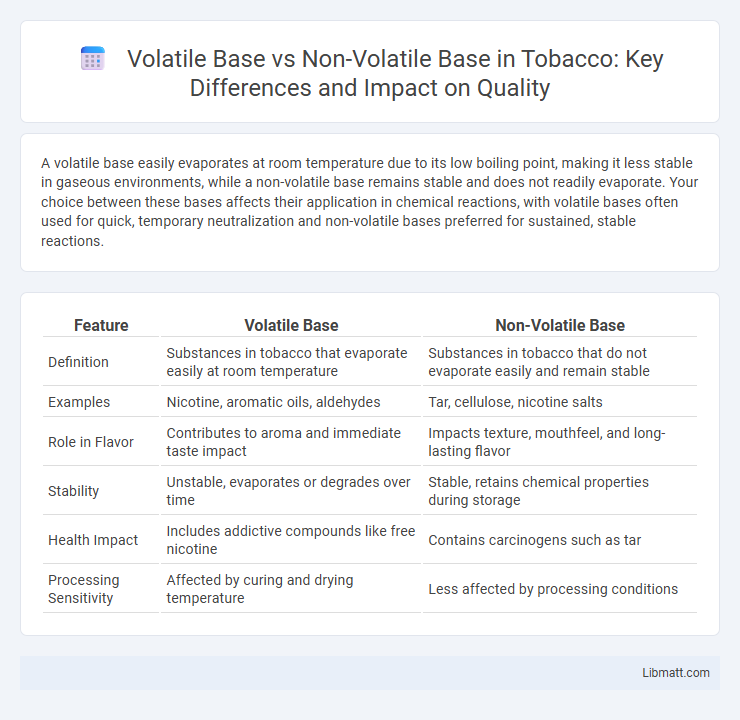A volatile base easily evaporates at room temperature due to its low boiling point, making it less stable in gaseous environments, while a non-volatile base remains stable and does not readily evaporate. Your choice between these bases affects their application in chemical reactions, with volatile bases often used for quick, temporary neutralization and non-volatile bases preferred for sustained, stable reactions.
Table of Comparison
| Feature | Volatile Base | Non-Volatile Base |
|---|---|---|
| Definition | Substances in tobacco that evaporate easily at room temperature | Substances in tobacco that do not evaporate easily and remain stable |
| Examples | Nicotine, aromatic oils, aldehydes | Tar, cellulose, nicotine salts |
| Role in Flavor | Contributes to aroma and immediate taste impact | Impacts texture, mouthfeel, and long-lasting flavor |
| Stability | Unstable, evaporates or degrades over time | Stable, retains chemical properties during storage |
| Health Impact | Includes addictive compounds like free nicotine | Contains carcinogens such as tar |
| Processing Sensitivity | Affected by curing and drying temperature | Less affected by processing conditions |
Introduction to Volatile and Non-Volatile Bases
Volatile bases, such as ammonia, readily evaporate at room temperature due to their high vapor pressure, making them detectable by their characteristic odors. Non-volatile bases like sodium hydroxide remain stable and do not easily vaporize, contributing to their persistent presence in solutions and solid forms. Understanding the distinction between volatile and non-volatile bases is crucial for your applications in chemical synthesis and safety protocols.
Definition of Volatile Base
A volatile base is a chemical compound, typically a low molecular weight amine or ammonia, that easily vaporizes at room temperature due to its high volatility. It contrasts with a non-volatile base, which remains largely in the liquid or solid phase under similar conditions and does not readily evaporate. Common examples of volatile bases include ammonia (NH3) and methylamine, widely studied in environmental and industrial chemistry for their rapid release into the atmosphere.
Definition of Non-Volatile Base
A non-volatile base refers to a chemical compound that remains stable and does not readily evaporate or vaporize at room temperature. Unlike volatile bases, non-volatile bases maintain their physical state without significant loss through evaporation, making them essential in applications requiring consistency in composition. Examples include ammonia solutions and certain amines that exhibit low vapor pressure and prolonged persistence in the environment.
Chemical Properties of Volatile Bases
Volatile bases, such as ammonia and amines, possess the chemical property of easily evaporating at room temperature due to their low boiling points and weak intermolecular forces. These bases readily release ammonia gas or other nitrogen-containing compounds when heated or exposed to acidic environments, distinguishing them from non-volatile bases like metal hydroxides. Your understanding of volatile bases is crucial for applications in chemical synthesis and environmental monitoring where gas-phase reactions play a significant role.
Chemical Properties of Non-Volatile Bases
Non-volatile bases exhibit low vapor pressure and do not readily evaporate at room temperature, making them chemically stable under standard conditions. These bases typically have strong molecular bonds and high boiling points, contributing to their persistence in various chemical environments. Their chemical properties often include high solubility in polar solvents and the ability to form stable complexes with metal ions, distinguishing them from volatile bases.
Examples of Volatile Bases
Volatile bases are compounds that easily evaporate at room temperature, commonly including ammonia (NH3), methylamine (CH3NH2), and ethylamine (C2H5NH2). These bases readily release vapors due to their low boiling points and high vapor pressures, distinguishing them from non-volatile bases like sodium hydroxide (NaOH) or potassium hydroxide (KOH), which do not readily evaporate. Understanding the volatility of your base is crucial when selecting chemicals for applications requiring rapid vaporization or minimization of residue.
Examples of Non-Volatile Bases
Non-volatile bases, such as pyridine, aniline, and triethylamine, are characterized by their low vapor pressure and stability under heating, making them suitable for various chemical processes where evaporation is undesirable. These bases maintain their integrity without readily evaporating, ensuring consistent reactivity and ease of handling in laboratory or industrial settings. Your choice of a non-volatile base can enhance safety and efficiency in reactions requiring prolonged heating or vacuum conditions.
Key Differences Between Volatile and Non-Volatile Bases
Volatile bases, such as ammonia, readily evaporate at room temperature due to their low boiling points, while non-volatile bases like sodium hydroxide have high boiling points and remain stable in solid or liquid form. The key differences include volatility affecting handling and storage, as volatile bases often require sealed containers to prevent loss, whereas non-volatile bases are safer for long-term use. Your choice between these bases should consider the application's sensitivity to evaporation and the necessary chemical stability.
Applications and Uses in Industry
Volatile bases, such as ammonia, are widely used in refrigeration systems and wastewater treatment due to their ability to evaporate readily, enhancing heat transfer and odor control. Non-volatile bases like sodium hydroxide are essential in chemical manufacturing, detergent production, and pH regulation because of their stability and strong alkalinity. Industries leverage volatile bases for processes requiring quick ammonia release, while non-volatile bases are preferred for applications demanding sustained alkalinity and corrosion resistance.
Summary and Comparison Chart
Volatile bases readily evaporate or decompose at room temperature, typical examples include ammonia and methylamine, which exhibit high vapor pressures and strong odors, whereas non-volatile bases like sodium hydroxide and potassium hydroxide remain stable and low in vapor pressure under standard conditions. In chemical reactivity, volatile bases often act as weak bases in aqueous solutions, while non-volatile bases, being typically ionic compounds, display strong basicity and high melting points. Summary and comparison charts highlight differences in physical state, vapor pressure, odor intensity, solubility, and common industrial uses, essential for selecting appropriate bases in chemical synthesis, manufacturing, and environmental applications.
Volatile base vs Non-volatile base Infographic

 libmatt.com
libmatt.com